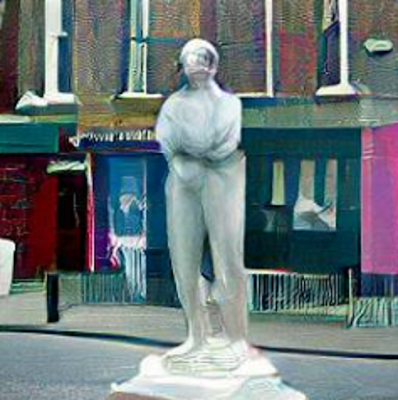The original cast of the UK soap opera, EastEnders, were hired on the basis of their similarity to statues and people depicted in wall murals, around London
 |
| Image generated using craiyon |
Crossposted from r/ImaginaryLondon
In 1983, the screenplay writer, Charles Hayhurst, who was riding high on the success of his 4-part drama - Whispering Upwind - approached the BBC with an idea for a new show.
“It was a high concept drama,” recalls former commissioning editor, Scot Kingsbury. “Statues in London come to life and have to find a place in contemporary society, which they achieve with varying degrees of success.”
“I had this concept that was provisionally titled Dawn of a New Day,” says Hayhurst. “I wanted to explore the idea of London as being one of those points of convergence, where people from all over the world will come and build lives for themselves, “No matter who you are, or where you are from, there will be somewhere in the capital where you will fit in. That kind of thing.
“The show was also about the organic process of integration. Linger in the big city long enough and you will become a Londoner by default. That's is a hard characteristic to define in words but, by the same token, you know a Londoner when you see one.
“The other theme that I wanted to explore to was the idea that, within each one of us, there lies the potential for phenomenal success or catastrophic failure. Those threads play out through the storyline of Susan Thursfield, who was a heroine and ultimately also a victim of a cotton dust explosion at a mill on Dunkley Court, in Poplar. In the show, she rises to the position of Deputy Prime Minister. Then there's Charles Golding who was the scion of a very wealthy family, and who joined the army against the wishes of his parents, and was posthumously commemorated for his valour at the Battle of Waterloo. In the script outline, unbeknownst to him, he is experiencing post-battlefield trauma, He finds it hard to fit in anywhere and winds up in prison. My plan was to slowly redeem him.”
Despite the guarded support of Kingsbury, Hayhurst's proposal was turned down:
“I was told that the programme would be too expensive to make and was unlikely to appeal to a large enough audience to justify its budget,” he says. “Ten years later they spent millions building something like an entire town for Eldorado.”
Although Dawn of a New Day had fallen at the first hurdle, Kingsbury retained a fondness for the idea. A year or so later, with open casting set to begin for what was to become the long-running London-based soap opera, EastEnders, he saw an opportunity to bring Hayhurst's vision to life, albeit behind the scenes:
“I said: 'Look, we're setting this story in London, so why not nod in the direction of some of the capital's most note-able former residents and employ actors based on their similarity to statues in the city?' That went down fairly well, but then people started pointing out that the figures who are generally commemorated as statues tend to be drawn from a certain type.
“It was suggested, not by me - I think it was Beryl Adams - that there are a much broader range of people portrayed in wall murals around the city, so why include those as well? So that's exactly what we did.”
“I had a small team going around London taking photos of the statues, along with any street portraiture they encountered,” recalls Helen Peck. “The problem with the statues was that they represented personages from bygone eras, so they weren't contemporary in their appearance. I had Lucy Edmond, who worked on the facial reconstruction of archaeological skulls for the history programme, Faces from out of the Past, make life-size mock-ups of the statues. I handed these over to the costumes, hair and make-up department to give them a modern makeover... My god, do you remember the opening titles to that show – all those waxen faces peering up at you from under the water, like there'd been a mass drowning. Absolutely bone chilling.
“With the mural art, I had a pair of courtroom artists flesh out the paintings. Originally they both worked out of the same room, but they argued so much people began to complain about the noise. In the end I had to put them in different buildings at Television Centre.
“Within a matter of months I submitted a casting palette to the production team. It was by far the strangest commission of my career.”
Actors who formed part of the original line-up of EastEnders were initially unaware of the reasons why they had been cast in the roles, with one exception:
“I was one year out of RADA and was struggling to find work,” says Derek Fry. “One of my friends who worked for the BBC told me that they were casting actors based on their resemblance to statues and people in street art. I arranged to have my giant, full-body portrait painted on the outer wall of an abandoned warehouse in the Docklands. It was like a giant. You could clearly see it from the road. When I turned up for the audition, they showed me a photo of the painting and said: 'Is this you?' I naturally feigned innocence. I said: 'I've never seen him before in my life, but he is a very handsome young gentleman.'
“The five years I spent working on EastEnders [as Peter Beale's illegitimate mixed-race son, Colin Beale] were some of the happiest times of my life.”
The other actors were made aware of the reasoning behind their casting in a documentary commemorating the 10th anniversary of the soap opera:
“It was a shock, but a pleasant one,” recalls Chris Firminger. “Thanks to my resemblance to Keith Kelty, who invented the double-four-stroke steam engine, I was cast in the role of Dr Legg's nemesis, Dr Acreman. It was 30 more years before Richard Ovendon told me my character's first name, which is Francis. There's your scoop. I'd been killed off by then.”
For Jasmine Durrant, who played the young Elizabeth Wilsher for two years, before the role was recast, the experience provided a reconnection to her family's past:
“I was cast on the basis of my resemblance to Joy Scutchings, who is one of the three little girls in the statue of Trinidadian immigrant family disembarking from a ship, at the end of Coopers Row, in Limehouse. It turned out that I was related to her. Unfortunately, I never met her in person. I still put flowers on her grave.”
Following the initial casting, future roles in EastEnders were developed more organically:
“There were no more statues or murals,” recalls Kingsbury. “I managed to wrangle a small payment on behalf of Charles, whose star had fallen by them. He went on to become an occasional writer for the soap.”
“It was a funny five minutes,” says Charles. “After a while the music stopped and all of the statues returned their plinths. I felt a touch of sadness. Then again, the music stops for all of us in the end, doesn't it?”
~ Sam Redlark



Comments
Post a Comment